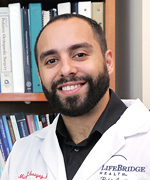Neonatal Sepsis Sequelae
What are neonatal sepsis sequelae?
Neonatal sepsis is a broad term referring to a blood stream infection that occurred very young in life. Typically, affected infants are severely ill. Due to their small size and other medical problems, the infection often has a wide spectrum. The infection can be located in practically any area of the body initially, and it spreads throughout the body fairly rapidly. Sequelae are conditions that occur due to a previous injury or disease. Neonatal sepsis sequelae result from the neonatal sepsis blood infection.
What are the symptoms of neonatal sepsis?
Infants with neonatal sepsis are generally noted to have a decrease in activity and movement, along with fevers, difficulty breathing, high heart rate and rash.
How does neonatal sepsis affect the bones?
From an orthopedic perspective, the final common pathway for the neonatal sepsis sequalae is the presence of bacteria in the bone. This can range from an infection that is not detected at the time and is treated with antibiotics, to an acute joint infection and/or bone infection. For bone infection, either obvious or silent, the growth plate may be damaged, creating a variable effect on growth. In some cases, the bone will grow normally for a period of time (years) and then have abnormal growth later in life. This abnormal growth can lead to leg length discrepancy or bone deformity. Parents are often the first to note these changes, as they are the most involved in the child’s daily life.
What are the different orthopedic sequelae of neonatal sepsis and how are they treated?
There are multiple options for treatment of abnormal bone growth depending on the severity and nature of the abnormality. Advanced imaging techniques such as MRI or CT scans are useful to help determine the best options.
Growth Arrest
Growth arrest in the setting of neonatal sepsis often occurs in a delayed manner, sometimes late in adolescence. These growth arrests occur when bone forms across the cartilage of the growth plate, tethering it in place. In addition to the bony bar formation, the growth plate is often considered “sick” and does not have the same growth potential as an unaffected plate. As a result, monitoring for growth disturbance and deformity is important in children affected by neonatal sepsis.
A complete growth arrest occurs when the damage to the growth plate is severe enough that no potential growth remains. The resulting leg length discrepancy develops most rapidly during periods of rapid growth. Depending on the bone affected, limb lengthening can be done on the shorter limb with internal fixation or an external fixator.
A partial growth arrest occurs when the growth plate damage causes asymmetric growth throughout the growth plate. The result is an angular bone deformity. Partial growth arrests can often be treated with a physeal bar resection, (see growth arrest condition page for an illustration of this procedure), allowing return to growth potential. This procedure removes the damaged area of the growth plate so that growth can continue normally. This can be done when a large amount of potential growth remains—when less than 40% of the growth plate is damaged, and the child has at least 2 years of growth remaining until s/he is skeletally mature. The damaged area is replaced with a piece of fat from the child’s body to prevent reformation of a bony bridge. After bar resection, a period of normal growth usually follows. However, as the plate remains “sick” as a result of the original injury, recurrence is not uncommon.
Bone Deformity
Bone deformity as a result of asymmetric growth is not uncommon. Both limb length discrepancy and angular bone deformity are usually present. A combination of treatments is generally needed: bar resection, guided growth, limb lengthening, and bone deformity correction are all potential options depending on the individual circumstances. To learn more about how the International Center for Limb Lengthening corrects bone deformities, please see Deformity Correction: The Process.
Bone Defects
From an orthopedic perspective, segmental bone defects are the most severe form of sequelae from neonatal mental defects present multiple challenges. Due to the severity of the infection, growth arrests and angular deformity are often present. Multiple options are available for treatment of segmental bone defects secondary to infection including bone transport (moving a segment of bone slowly, allowing lengthening and healing together), shortening and then lengthening, or the Masquelet procedure, which induces a new membrane to take the place of the periosteum. Bone graft is then placed into the membrane to allow restoration of bone tissue.
Why choose the International Center for Limb Lengthening for treatment of neonatal sepsis sequelae?
Neonatal sepsis is an uncommon condition, and the orthopedic manifestations are both rare and severe. The ICLL has a team of experienced surgeons, physical therapists, physician assistants and nurses who specialize in taking care of children with these complex issues. Your doctor will take the time to make sure you understand all of your options and then will customize your child’s treatment to meet his or her specific needs. We help patients with neonatal sepsis sequelae achieve their best possible result.



